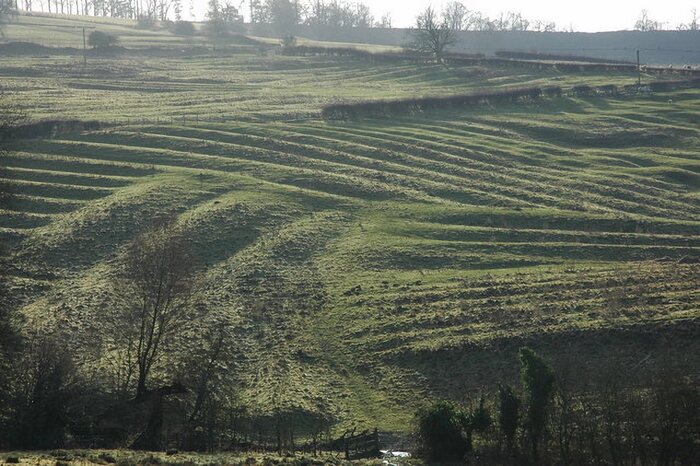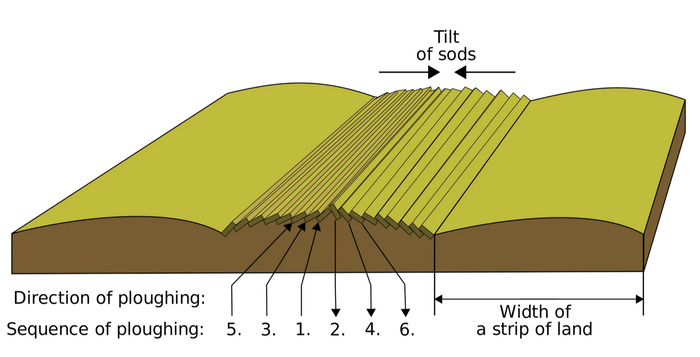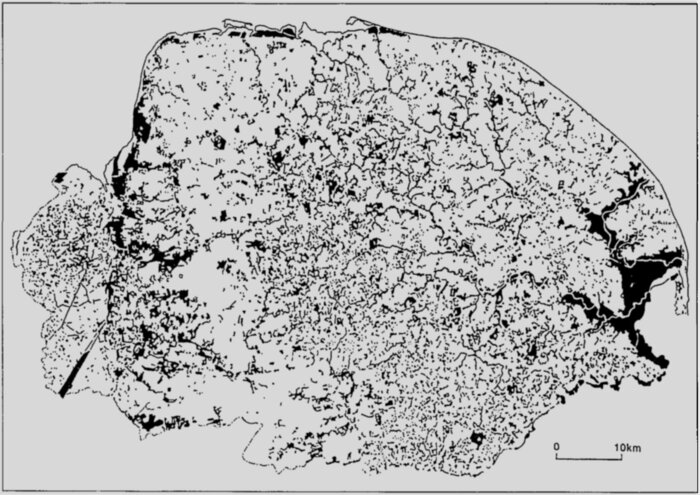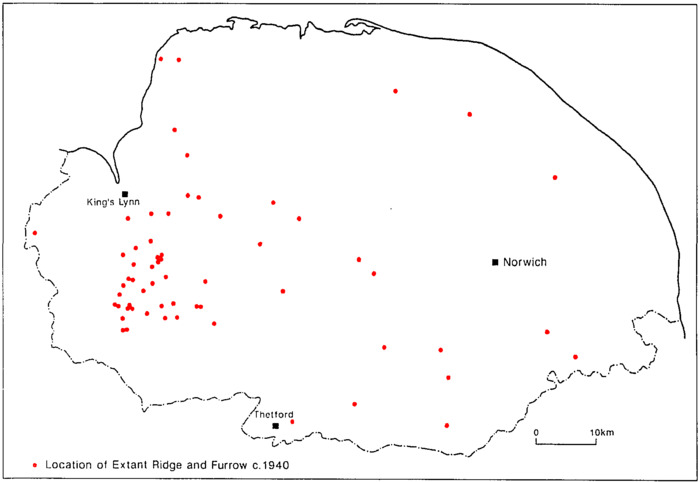Ridge and furrow looks like a cover up. Fri 01 December 2023
The lie of the land. Source: Medieval Ridge and Furrow above Wood Stanway
Location: Wood Stanway: Google Maps
If you weren't already familiar, then:
Source: Ridge and Furrow
Fortunately, experts have the answers:
It was primitive ploughs and unwieldy oxen. Source: Into the picture podcast: Ridge and Furrow
Unfortunately, their answers only raise further questions and furrow more brows. Especially if you've actually read What is Medieval Ridge and Furrow and appreciated the volume of bullshit involved.
For example, it implies medieval plough-boys ploughed the same furrows year in, year out, planting grains on the well-drained ridges and water-loving crops in the wetter furrows year in, year out.
But any vegetable knows that's unlikely. The practice would deplete both your soil's fertility and its plough-ability.
Official diagrams don't help:
It's a tilting sod. Source: What is Medieval Ridge and Furrow
Quite how the back and forth trottings of heavy oxen would produce lines of raised ridges and sunken furrows is beyond thick people like me.
This may be why experts have developed so many answers to ridge and furrow's riddles. Answers from which contradictions sprout like weeds.
Take for example the orientation of ridge and furrow:
They're on contour. Source: What is ridge and furrow
I'm not sure the top-of-page image supports that claim. But I'm even less sure this next video supports it:
On contour - except when they're not. Source: Old Rigg and Furrow Arable Farming - Landscape Archaeology
However, why quibble with experts?
Especially when they are happy to quibble for me:
Even with themselves. Source: Ridge and Furrow
Who knew all farmland in England is oriented north-south, both with the contour and across it, and aligned with the midsummer solstice?
Presumably not the folks who ploughed this:
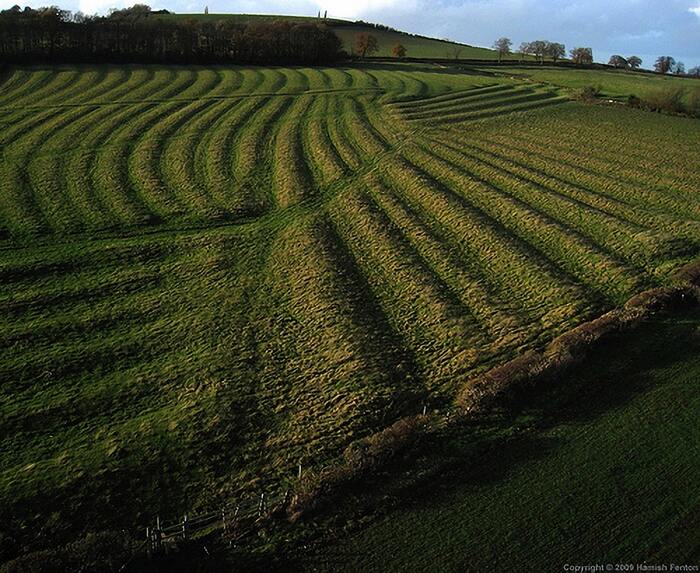
Check the patch top-right. Why? Source: Cotswolds Ridge & Furrow Farming
Like the Wood Stanway ridge and furrow patches in the image at the top of this page, this patchwork prompts a key question: if ridge and furrow demonstrates the difficulty of turning old ploughs and oxen teams around, why plough short strips? Why not reduce time-wasting turnaround time by ploughing the longest possible strips?
How did they even turn an ox team around without damaging the neighbouring ridge and furrow?
Expert explanations for the height and width of ridge and furrow are less amusingly self-contradictory than explanations for its orientation. Instead, explanations for its dimensions are amusing because they contradict the existence of universally acknowledged natural forces like gravity.
And commonsense.
From Cotswolds Ridge & Furrow Farming:
Surviving ridges are parallel, ranging from 3 to 22 yards (3 to 20 m) apart and up to 24 inches (61cm) tall – but were up to six feet tall when in use.
Six feet tall? Two metres high?
Were they ploughing fields or mass-graves?
Actually, many of them probably were mass-graves. Though they had been fertilised before the ploughs arrived.
But that's for later. For now, just note that primitive medieval ploughshares apparently piled new soil on top of the soil displaced the previous year.
With that gravity-defying soil in mind, let's return to Cotswolds Ridge & Furrow Farming and its comments about width:
Got it: eight yards on average. Source: Ridge and Furrow
If - as is usually claimed - medieval families sowed on both the ridge and in the furrow, how did they prepare an eight-yard wide ridge for sowing?
Not by ploughing it, obviously.
Experts attribute this 5, 8 or 11-yard wide ridge-width to the wide turning circle required by a team of oxen. The public are presented with the notion that the plough-board gradually created a wide mountain - albeit a long, low and rounded mountain - out of a pile of bullshit. Or a trough of it.
Try it yourself with a spade some time.
In this scenario, medieval soil tumbled through the air at head height for several yards to the left of the plough. Medieval farmers apparently bred, fed and daily harnessed all-terrain oxen of titanic strength.
To be fair, some experts do admit ridge and furrow isn't quite the settled science it is portrayed to be:
Though they tend to live in prosperous economies. Source: Lauresham digital - Ridge and Furrow Research project
In Britain, one brave expert did admit ridge and furrow doesn't stack up.
Robert Liddiard set out his concerns very carefully, perhaps even delicately. So I've used AI to simplify what he said.
In East Anglia, strips were usually ploughed flat, unlike in the Midlands, where they were cast up to form ‘ridge and furrow’ (Goudie, 2020). The survival of medieval ridge and furrow in England, including East Anglia, is notable in regions where the land has not been extensively ploughed or developed since the Middle Ages (RuralHistoria, 2023).
This quote implies ancient east Anglians never fell for the allegedly Roman oxen-pulled plough-share that created ridge and furrow everywhere else. No, they possessed an alternative plough-share. A plough-share that didn't pile up soil.
It's curious this technology didn't spread to the beleaguered Midlands, where - apparently between 440 AD and the 1800s - they wasted titanic amounts of oxen energy ploughing ridges up to 2m (6 ft, 6 in) high.
If that ludicrous scenario is true, it's no surprise medieval Midlands farmers eventually abandoned the plough for sheep and dairy pasture. Their disdain for ancient ploughing technologies might explain why so much ridge and furrow is visible in the Midlands today.
Liddiard didn't fall for this bullshit. He studied the fingerprints left by East Anglia's medieval miracle farming technology.
Here he summarises just a couple of the problems he encountered:
From The distribution of ridge and furrow in East Anglia: ploughing practice and subsequent land use, Robert Liddiard, Agricultural History Review, 1999:
some aspects of the practice are not clearly understood.
Norfolk, Suffolk, and Cambridgeshire retain relatively few examples of ridge and furrow. [And] There is an uneven distribution across the three counties, despite the fact that during the medieval period, open-field agriculture was ubiquitous.
Liddiard attributed the disparity to the enthusiasm of the region's modern farmers. He thought when new ploughing technology emerged - that would be the horse, then the tractor - East Anglian farmers had joyfully ploughed away most of their ridge and furrow.
The theory seems reasonable - especially if you consider East Anglians didn't have much ridge and furrow to begin with.
But that does raise the question: why did anybody else fall for it?
If you read Liddiard's paper, you may intuit he wasn't very convinced by his own argument. Perhaps he was trying to keep his job.
Helpfully, Liddiard mapped the uneven distribution of ridged and furrow in East Anglia. He even mapped Norfolk's remnant ridge and furrow against its pasture lands.
Here's his map of Norfolk's pasture land:
Black shows Norfolk's pasture land in the decade prior to 1938. Source: The Distribution of Ridge and Furrow
And here's his map of Norfolk's remnant ridge and furrow. The red blobs denote patches of ridge and furrow:
Norfolk ridge and furrow as surveyed around 1943. Source: The Distribution of Ridge and Furrow
Not much correlation.
As Liddiard already knew, Norfolk didn't have much ridge and furrow. But what ridge and furrow there was should have correlated with Norfolk's pasture land. On the basis that no matter how they ploughed it, farmers of any era prefer to plough flat, fertile pasture land.
As Liddiard's second map shows, what ridge and furrow remained in Norfolk was certainly on pasture land but it was clustered in the west. While Liddiard's first map showed pasture was much more widespread across Norfolk, especially to the east.
Liddiard attributed this non-correlating cluster-muck to a theory that could be described as: "the eastern East Anglia was an early adopter of superior non-Roman/non-medieval ploughing technology" theory. It claims modern farmers in east Norfolk machine-ploughed away any remnant ridge and furrow. Liddiard half-heartedly proposed this modern ploughing had struggled in west Norfolk compared to earlier ploughing technologies - and that was why more ridge and furrow remained in the west.
But as far as anyone knows, Norfolk's farmers didn't have beta-tester access to tractors. And west Norfolk's ridge and furrowed pasture is just as ploughable by tractors as pasture in any other part of Norfolk.
But the red-faeced blobs of ox-shit - OK: ridge and furrow - on Liddiard's second map do roughly correlate with something else:
West Norfolk's Gauld was worth digging for. Source: The Origins and Development of the British Coprolite Industry
The patch of geology beneath west Norfolk's ridge and furrow is 'Greensand' and 'Gauld' clay. This map suggests the presence of ridge and furrow depends on what was buried underground and not what was ploughing the ground.
This correlation may help unlock a better understanding of what ridge and furrow was really about.
And the real origin of ridge and furrow.
© All rights reserved. The original author/creator of each image, video, quote or text retains full ownership and rights.
More of this investigation:
The Lie of the Land,
More of this investigation:
Writing Past Wrongs
